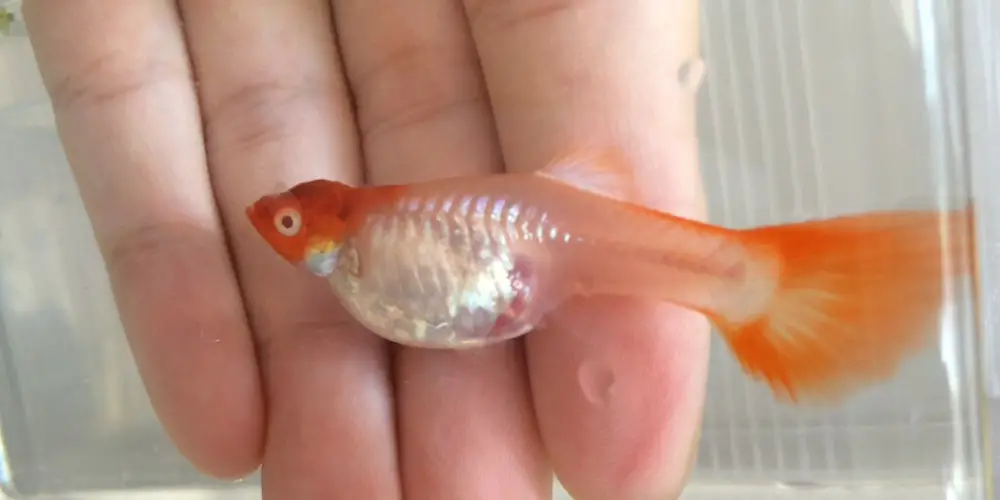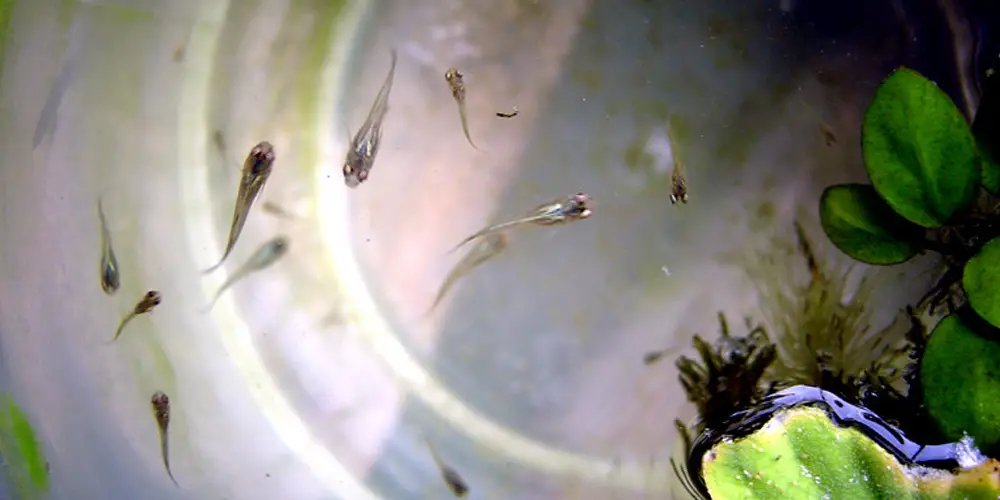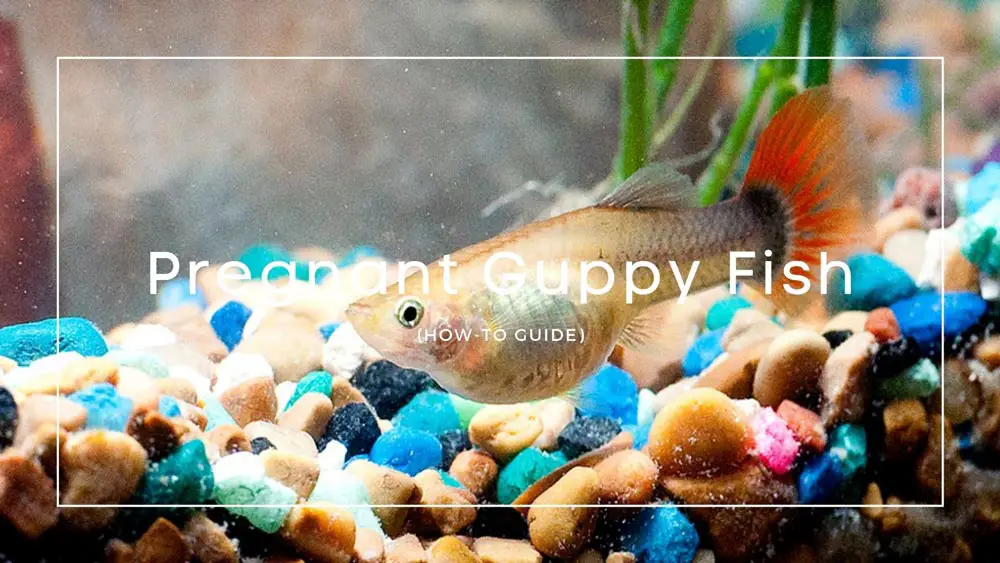Much like when we find out our friends or relatives are expecting, finding out one of our pets is expecting is extremely exciting. However, taking care of a pregnant fish might seem a bit overwhelming for the new fish owner.
In this article, we are going to cover what to expect when your guppy is expecting a little bundle of baby fish. We are going to explore the guppy gestation, caring for your pregnant guppies, and so much more!
If you suspect that your guppy might be expecting babies, then join us as we discuss what to expect on this wild ride.
How to Tell if a Guppy is Pregnant?
Unfortunately, there is no pregnancy test that you can dip in the water to learn if your guppy is pregnant or not. However, there are many symptoms you can look out for that will help you discern if you may be expecting some baby fish soon.
Some pregnant fish will show a physical sign such as a bulging belly. At first, this may be hard to definitively show whether or not your fish is expecting. Bloating can happen in fish too, so a little bit of a belly is not always a sign of pregnancy. However, if you notice a guppy’s belly slowly growing larger over time, you can safely assume the guppy is pregnant.
Guppies also have some fairly distinct behavior that they exhibit when they are in the season of mating. You can see when males chase females in order to mate them, they will chase them until they make them too tired to move anymore. The female has no choice but to stop running and allow the male to mate with her. If you see this, then there is a good chance the female will be pregnant soon.
Pregnant guppies may also shake or shiver when they normally would not. You may notice a pregnant guppy rubbing herself along the wall of the tank or rubbing against decorations within your tank.
While none of these symptoms alone will show that your guppy is pregnant, if a guppy is showing multiple symptoms, then you can be pretty certain she is pregnant.
Pregnant Guppy Stages and Gestation?
Each and every guppy will actually have a unique situation that will change her gestation period. Factors such as the guppy’s overall health, the conditions in the tank and water, and the stress level of the mother guppy.
On average, the gestation period for a guppy is pretty short. Research suggests that guppy gestations last from 21 to 31 days but pregnancy ending from 22 to 26 days is most common.
This short period of gestation does not give the fish owner much time to notice the pregnancy or to prepare for the possibility of baby guppies. Keeping an eye out for mating is a good idea if you would like to be prepared for a baby guppy takeover.
However, female guppies can actually hold and store male sperm for up to 8 months. This means that theoretically your female guppy could become pregnant long after you bring her home from the pet store.
An interesting fact about this is that the long period of time that sperm can live within a female guppy is considered a means of survival. Male guppies tend to only have a lifespan of around 2-3 months. Females, on the other hand, can survive for around 2 years. Storing sperm allows the female guppy to have babies even if no male is around.

Can You Speed Up Gestation in Guppies?
If you are wanting to decrease the already short gestation in a pregnant guppy, there are a few things you can do to reduce the pregnancy time.
You can start by slowly increasing the temperature in the tank the guppy lives in. It is not a good idea to suddenly heat your tank up very quickly, so the key is to increase the temperature slowly.
This will take you several days. Each morning, simply set the heater inside of your tank to a slightly higher temperature. You only want to increase the temperature by one or maybe two degrees at a time. Raising the temperature too high or too quickly could actually cause the pregnancy to terminate.
Another method for decreasing the time gestation takes within guppies is to switch the pregnant guppy to a high protein diet. Changing their food to include bloodworms or even purchasing some brine shrimp is a great way to do this.
If you want to give your guppies the most high protein quality food, feed them live shrimp or worms. However, if you cannot get ahold of live foods, give them frozen ones over dried or canned foods.
These two methods are not guaranteed to reduce the gestation time, but they are certainly worth a shot if you are looking to decrease your wait time.

How Many Babies do Guppies Have at One time?
Guppies give birth to what is referred to as a live fry. If that sounds like a lot of fish babies, it actually could be! A live fry can be anywhere from 2 to 200 fry at a time.
The birth can last upwards of 6 hours, but it could go all the way to 12 hours if the mother guppy is actually stressed.
Do not panic. Guppies who are pregnant will not always give birth to 200 fry, and not all of them will survive. In fact, Guppies are one of many fish species who turn cannibalistic after they give birth. If you do not remove her from her fry, she may eat them all.
Why Pregnant Guppy Not Giving Birth?
There are a few reasons why a guppy may not give birth, even if you know that she was most certainly pregnant. This may be concerning as a pet owner, but it is actually common for a pregnant guppy to abort the pregnancy in certain conditions.
If the temperature in your tank is too low, then a pregnant guppy will not give birth. Make sure that you check the temperature and do not lower it if you believe your guppy may be pregnant.
A stressed out guppy will also sometimes not give birth in time. This can happen if your guppy feels crowded or if the other fish in the tank do not leave her alone during the gestational time she will not give birth.
Caring for a Pregnant Guppy?
Caring for a pregnant guppy is not that different from caring for your guppy any other time. However, there are a few things that you may want to consider when caring for a pregnant guppy.
First, you may consider adding more variety into your pregnant guppy’s diet. This can help to avoid deficiencies that would terminate or risk the pregnancy. As mentioned above, you may want to add brine shrimp or blood worms into the diet. You can also alternate pellets, flakes, and even algae discs to make sure she gets what she needs.
As mentioned before, you will want to help your pregnant guppy avoid stress. Other fish in the tank can stress the pregnant mother out, especially if she has no way to hide from those other fish. The mother may absorb the babies rather than give birth which will obviously end the pregnancy.
You may consider purchasing a breeding box to help your pregnant guppy fish separate from the other fish in the tank. However, you want to make sure that this is not done too soon. Being in a breeding box may actually cause even more stress, so you do not want to do this early.
A breeding box is a good place for the pregnant guppy to have her fry for various reasons. Having the fry in a breeding box can allow you to quickly separate her from the fry without the risk of her eating them.
Signs Your Guppy is Ready to Give Birth
When the pregnant guppy is ready to give birth, then he or she will begin to display some specific behavior that can be an indicator of the beginning stages of labor. Typically, a guppy who is ready to give birth will display at least two of the following behaviors, if not more.
You will need to know this information especially if you are planning to place your pregnant guppy in a separate tank or a breeding box. These signs are tell-tale signs that the guppy should be moved.
Her Belly Changes Shape
We have mentioned how a pregnant guppy will have a bulge in her belly. When she is about to give birth, this bulge will take more of a square shape and will actually seem a bit bulkier than it ever has before.
Staying Put
If your pregnant guppy seems to be swimming in one place rather than moving about the tank, then this may be a sign that labor has begun. This is actually one of the most commonly reported behaviors that a guppy is about to give birth.
Hiding & Rubbing
Fish frequently hide in the foliage at the bottom of an aquarium. However, excessive hiding can be a sign that a pregnant guppy is about to give birth.
Rubbing her body along the plants or decorations at the bottom of the tank can also be a sign of labor. Your guppy may also rub her body along the walls of the tank, all of these are signs that your pregnant guppy is about to give birth.
Nervous or Aggressive Behavior
When you approach the tank, the guppy may get nervous. This is a good sign that labor has begun. This is marked by the guppy suddenly hiding when she sees you approach the tank.
You may also notice aggressive behavior from a guppy in labor. The guppy may bite or chase other fish that come near her. This a good sign that labor has begun.
Other Signs
If your guppy is routinely flexing her spine, then this is a sign that labor is looming. This can be easily spotted if the guppy moves her tail in an upward movement.
Shaking or shivering can also be a good sign that the guppy is in labor at the time of observing this behavior.
The last sign that a guppy is actively in labor is that she refuses to eat. Guppies who are in labor will not swim for food or show any interest in feeding time.
Moving Fry from Breeding Tank to Main Tank
Introducing the baby guppies to the main tank actually has a few important steps on its own. You want to make sure you do this in a way that insures their survival.
Make sure that the baby guppies have had plenty of time to grow and thrive on their own. You will want to make sure they are about an inch long, but the other fish may still be big enough to eat them at that time.
You also want to ensure that all of the fish in both tanks are healthy before combining the tanks. Otherwise, this could have devastating effects on the tank as a whole. You can easily check the health of the fish by looking for spots and looking out for odd behavior.
As mentioned before, smaller fish need a lot of hiding places to make sure that they are not at risk for being eaten. Being able to hide will also reduce their stress in a new place.
As usual, you will want to ensure that the tank is the same temperature as the breeding tank.
One last pro tip, go ahead and feed the fish in your community tank. This will make the small fish much less appetizing if the bigger fish are already full from eating their daily meal.
Final Thoughts
Having a pregnant guppy is an exciting adventure and can be really fun to watch. However, it is important that you take the necessary advice to keep your pregnant guppy and her babies safe. Good luck on this new adventure.





